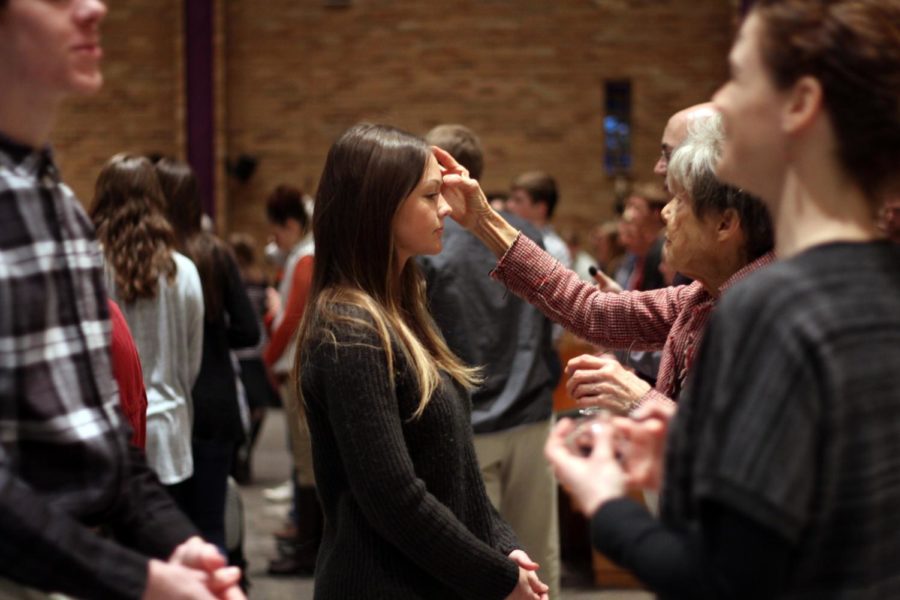All about Ash Wednesday
Hannah Olson / Iowa State Daily
A parishioner receives ashes on her forehead during Ash Wednesday mass March 1, 2017, at St. Thomas Aquinas Catholic Church. Ash Wednesday marks the beginning of the season of Lent for Christians.
March 5, 2019
In the days leading up to Lent, Ash Wednesday is more than a marker of time.
Anne Clifford, a Msgr. James A. Supple Chair of Catholic studies, outlined the context of the background of this Christian holy day.
The term “Ash Wednesday” comes from the annual Christian practice done worldwide among the various Christian denominations – from Catholicism to Lutheranism to Presbyterians to some Baptists.
Wednesday marks the 40 days before Easter and the first day of Lent, a time for observing and honoring the work of Jesus Christ.
In the Bible, Jesus spent 40 days in the desert fasting and praying before he began teaching the word of God as a minister to the people. The observances of Ash Wednesday and Lent include personal sacrifices as a way of remembering Christian origins and human mortality.
Specifically, the act involves the placing of ashes on the foreheads of members of the congregation as a reminder of regret for sins in the past. This is done in the shape of a cross. Prompting the person receiving the ashes of humanity, the priest or pastor says, “Remember that you are dust, and to dust you shall return,” quoting the Old Testament of the Bible, Genesis 3:19.
Traditionally, ashes are created by burning the palm leaves used in a church’s Palm Sunday of the previous year.
Clifford also said the holy day is “a time to reflect on life” and a time for students to put their lives back into perspective. She explains we, as humans, are on Earth for a short time.
“What do you want to do in the meantime? Where do you want to put your energy?” Clifford said.
Besides the act of receiving the ashes, Clifford says this annual practice is a time for bringing ourselves back to center, especially if we are unable to be with our loved ones.
“Connection with your family for religious seasons also bring back cherished memories of what the faith meant for your family,” Clifford said.
Services are a good time to reconnect with one’s faith, but also to learn in a new environment that was unavailable before coming to college.
Clifford added that the church is not the only place to regard Ash Wednesday and its teachings. In addition to reflection, March 6 can blossom into a new appreciation for faith. This can involve reading the Gospel more often, something as simple as reading a chapter a day to involve oneself in one’s faith commitment, Clifford said.
“It’s for the students to decide,” Clifford said.
Though the practice is more common in Catholicism, multiple churches in Ames are hosting Ash Wednesday services.
- Saint Thomas Aquinas has services listed for 7 a.m., noon, 5:15 p.m. 7:15 p.m. and 9:15 p.m.
- Ames First United Methodist Church: 7 p.m.
- Memorial Lutheran Church and Student Center: 7 p.m.
- St. John’s by the Campus: noon service in the main sanctuary and a 7 p.m. service in the Chapel.
- Wesley Center: 9 p.m. at 130 S. Sheldon
- Bethesda Lutheran Church: 6:30 p.m.
- First Baptist Church: 6:30 p.m.
- Harvest Vineyard Church: 6:30-8 p.m.
- First Christian Church: 7 p.m.
- Northminster Presbyterian Church: 6:30 p.m.
- Collegiate Presbyterian Church: 7 p.m.
- Ames United Church of Christ: Midday Ash Wednesday Prayer Service at 12:15 and Ecumenical Ash service at 7 p.m.
















